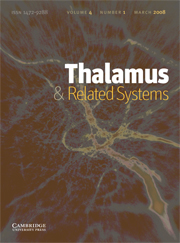Article contents
Dendritic organization in thalamocortical neurons and state-dependent functions of inhibitory synaptic inputs
Published online by Cambridge University Press: 12 April 2006
Abstract
GABA-ergic thalamic reticular neurons function generically or singularly in a state-dependent manner: during quiet sleep they synchronously and rhythmically inhibit thalamocortical neurons (TCNs) via bursts, thereby eliciting the low-threshold Ca2+ potentials in TCNs that are crucial to oscillatory network behavior in the thalamo-reticulo-cortical system; during wakefulness they shape the flux of ascending sensory information by inhibiting TCNs with asynchronous and arrhythmic single-spikes. To investigate how the reticulo-thalamic synapses, which occur throughout TCN dendrites, are able to effect such disparate functions, we have: (1) used a 1416 compartment model of a 3D reconstructed TCN; (2) triggered dendritic miniature (TTX-independent) and unitary (single-afferent) conductance-based synaptic events, and (3) recorded axial currents and voltage transients in all 1416 compartments simultaneously. For synapses at all dendritic locations, more than 79% of the charge transfer reached the soma, where it dispersed into other dendritic trees to return to the extracellular space. In accord, dendritic synapses in 80% of the arbor induced voltage responses that were severely attenuated at the soma (>75% loss). Spatio-temporal aspects of distributed postsynaptic responses were examined as well. Except for synapses in the 13 most proximal compartments, the amplitude and phase of the voltage responses degraded rapidly within a focal region that did not extend beyond the host tree, and was limited most often to a subtree. The bulk response (outside the focal region) was highly synchronous and uniform. Interestingly, there were not 1403 different focal regions, but only 20, each clearly distinct from the rest and sharply delineated. Structural attributes of the arbor determined their boundaries. Boundaries were invariant when the analysis was repeated on rescaled versions (length, diameter) of the reconstructed arbor. Unitary events also induced focal/bulk structures for both burst and single-spike triggers – paradigms that correspond to single-afferent drives during quiet sleep and arousal, respectively. Such qualities differ dramatically from previously proposed motifs of dendritic clustering, each of which carried nonlinear sensitivities to parameter values. We propose that dendritic clustering underlies the role of reticulo-thalamic synapses in the early processing of ascending sensory information and that bulk responses contribute robustness to the induction and maintenance oscillations in the thalamo-reticulo-cortical network.
Information
- Type
- Research Article
- Information
- Copyright
- 2001 Elsevier Science Ltd
- 2
- Cited by

